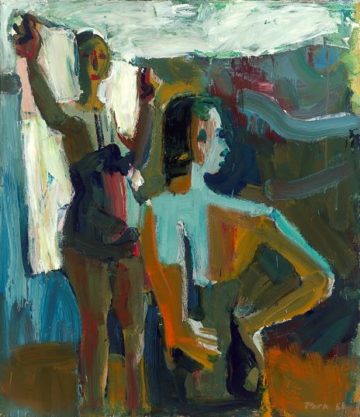
Originally published in The Marina Times San Francisco in November 2020
In the 1940’s, Abstract Expressionism was an American painting movement that grew to have a global influence on the visual arts. During that same period, David Park filled his Ford with his own Abstract Expressionist canvases and abandoned them at a city dump. Making a clean break from his past, Park went on to paint figures in his return to representational canvases, and in the process spearheaded the Bay Area Figurative Art Movement. Through January 2021, David Park’s retrospective at SFMOMA will be his first in three decades, and the first to focus on his entire career.
A Return to the Personal
Curator Janet Bishop said “He was a profoundly gifted artist who had two great loves: paint and people. Toward the end of his life, his fascination with the potential of his medium coupled with his appreciation for the human figure led to a group of canvases in which the universal humanity of his subjects comes pulsing through in the most powerful way.”
David Park used the figure as a means of communicating the universal simply by painting the everyday experiences of humanity. Park said “Quite often even the very fine non-objective canvases seem to me to be so visually beautiful that I find them insufficiently troublesome, not personal enough.” Drawing from his own experiences, Park painted scenes from his life in works like Rehearsal (ca. 1949-50) which pictures the jazz band for which he served as a pianist. Depicted from his vantage point behind the piano, torsos of players tightly pack the visual field in deep earth tones. Park’s experience with abstraction still informs his style, however – on the backs of the players simplified into bright color blocks, and through the floors and walls flattened into solid color. In Boston Street Scene (1954), the artist returns to a view of the neighborhood where he grew up, and in Interior (1957) his wife and fellow painter Elmer Bischoff posed as subjects.
An Expressive Peak
Two Bathers (1958), The Cellist (1959) and other works from this era became expressive high water marks in Park’s figurative art distinguished by looser brushstrokes and more colorful, vibrant palettes. Psychologically charged with a new intensity, this departure into a new style was sadly cut short by illness in 1960. While bed-ridden during his last months, Park produced a 30 foot long felt-tip pen scroll (which will be on view exclusively at SFMOMA) and a vivid gouache series depicting the human figure, alone and in groups, mothers and children, domestic activities and other everyday events.
David Park And His Circle: The Drawing Sessions
Concurrently on view on the museum’s second floor, David Park And His Circle: The Drawing Sessions gives the public a peek into David Park’s weekly figure drawing sessions with fellow artists Elmer Bischoff and Richard Diebenkorn in 1953. Repeatedly drawing models in varying poses and experimenting with traditional and unconventional materials, these artists gatherings grew over the years to include other friends and colleagues and were held in each other’s Bay Area studios. The gestures and attitudes of the models seem to trigger the imagination, and it’s hard not to wonder about the conversations that took place in these spaces and in between these posturings. 33 drawings and two sketchbooks are the remaining documents of these collaborative meetings.